The Global Tiger Forum kicked off a major tiger conservation meeting in New Delhi this week with exciting new numbers to report.
New census data shows the population of wild tigers to be twenty percent higher than 2010 estimates– with 3,890 roaming worldwide.
“For the first time after decades of constant decline, tiger numbers are on the rise. This offers us great hope and shows that we can save species and their habitats when governments, local communities and conservationists work together,” said Marco Lambertini, Director General of WWF International.
ALSO: Manatee Population Has Rebounded 500 Percent, No Longer Endangered
The meeting of tiger range governments at the 3rd Asia Ministerial Conference on Tiger Conservation this week is the latest step in the Global Tiger Initiative process that began with the 2010 Tiger Summit in Russia. Governments at that meeting agreed to the Tx2 goal to double wild tiger numbers by 2022.
Leonardo DiCaprio donated $1 million to the cause while in Russia for that conference.
Over the three day meeting, countries will report on their progress toward the Tx2 goal and commit to next steps. India’s Prime Minister Modi will address the conference on the essential role tigers play as a symbol of a country’s ecological well-being.
MORE: Monarch Butterfly Population More Than Triples Over Last Year
Tigers are classified as endangered by the IUCN Red List of Threatened Species, with habitat loss and poaching from a multi-billion dollar illegal wildlife trade identified as the major reasons.
In 2014, tiger range governments agreed to announce a new global tiger estimate by 2016, based on full, systematic national surveys. However, not all countries have completed or published these surveys. The new minimum estimate of close to 3,900 tigers–up from 3,200– is based on updates from countries where national tiger surveys have taken place since the IUCN assessment.
(Photo by Alex Walsh for WWF)




















